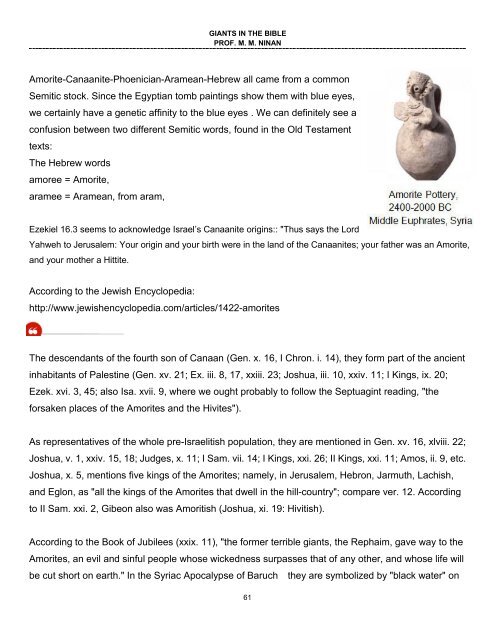Giants_in_the_Bible
Nephilims were on the earth, before and after the flood. Who are these giants? Were there other giant tribes and nations on the earth. How did they happen? A scriptural review on giants on earth.
Nephilims were on the earth, before and after the flood. Who are these giants? Were there other giant tribes and nations on the earth. How did they happen? A scriptural review on giants on earth.
You also want an ePaper? Increase the reach of your titles
YUMPU automatically turns print PDFs into web optimized ePapers that Google loves.
GIANTS IN THE BIBLE<br />
PROF. M. M. NINAN<br />
Amorite-Canaanite-Phoenician-Aramean-Hebrew all came from a common<br />
Semitic stock. S<strong>in</strong>ce <strong>the</strong> Egyptian tomb pa<strong>in</strong>t<strong>in</strong>gs show <strong>the</strong>m with blue eyes,<br />
we certa<strong>in</strong>ly have a genetic aff<strong>in</strong>ity to <strong>the</strong> blue eyes . We can def<strong>in</strong>itely see a<br />
confusion between two different Semitic words, found <strong>in</strong> <strong>the</strong> Old Testament<br />
texts:<br />
The Hebrew words<br />
amoree = Amorite,<br />
aramee = Aramean, from aram,<br />
Ezekiel 16.3 seems to acknowledge Israel’s Canaanite orig<strong>in</strong>s:: "Thus says <strong>the</strong> Lord<br />
Yahweh to Jerusalem: Your orig<strong>in</strong> and your birth were <strong>in</strong> <strong>the</strong> land of <strong>the</strong> Canaanites; your fa<strong>the</strong>r was an Amorite,<br />
and your mo<strong>the</strong>r a Hittite.<br />
Accord<strong>in</strong>g to <strong>the</strong> Jewish Encyclopedia:<br />
http://www.jewishencyclopedia.com/articles/1422-amorites<br />
The descendants of <strong>the</strong> fourth son of Canaan (Gen. x. 16, I Chron. i. 14), <strong>the</strong>y form part of <strong>the</strong> ancient<br />
<strong>in</strong>habitants of Palest<strong>in</strong>e (Gen. xv. 21; Ex. iii. 8, 17, xxiii. 23; Joshua, iii. 10, xxiv. 11; I K<strong>in</strong>gs, ix. 20;<br />
Ezek. xvi. 3, 45; also Isa. xvii. 9, where we ought probably to follow <strong>the</strong> Septuag<strong>in</strong>t read<strong>in</strong>g, "<strong>the</strong><br />
forsaken places of <strong>the</strong> Amorites and <strong>the</strong> Hivites").<br />
As representatives of <strong>the</strong> whole pre-Israelitish population, <strong>the</strong>y are mentioned <strong>in</strong> Gen. xv. 16, xlviii. 22;<br />
Joshua, v. 1, xxiv. 15, 18; Judges, x. 11; I Sam. vii. 14; I K<strong>in</strong>gs, xxi. 26; II K<strong>in</strong>gs, xxi. 11; Amos, ii. 9, etc.<br />
Joshua, x. 5, mentions five k<strong>in</strong>gs of <strong>the</strong> Amorites; namely, <strong>in</strong> Jerusalem, Hebron, Jarmuth, Lachish,<br />
and Eglon, as "all <strong>the</strong> k<strong>in</strong>gs of <strong>the</strong> Amorites that dwell <strong>in</strong> <strong>the</strong> hill-country"; compare ver. 12. Accord<strong>in</strong>g<br />
to II Sam. xxi. 2, Gibeon also was Amoritish (Joshua, xi. 19: Hivitish).<br />
Accord<strong>in</strong>g to <strong>the</strong> Book of Jubilees (xxix. 11), "<strong>the</strong> former terrible giants, <strong>the</strong> Rephaim, gave way to <strong>the</strong><br />
Amorites, an evil and s<strong>in</strong>ful people whose wickedness surpasses that of any o<strong>the</strong>r, and whose life will<br />
be cut short on earth." In <strong>the</strong> Syriac Apocalypse of Baruch <strong>the</strong>y are symbolized by "black water" on<br />
61

















